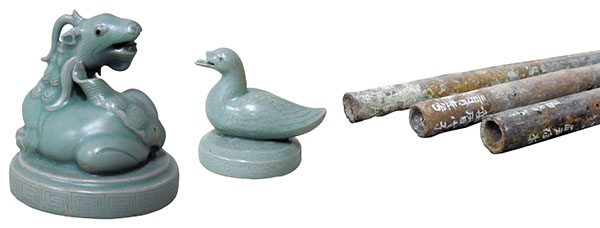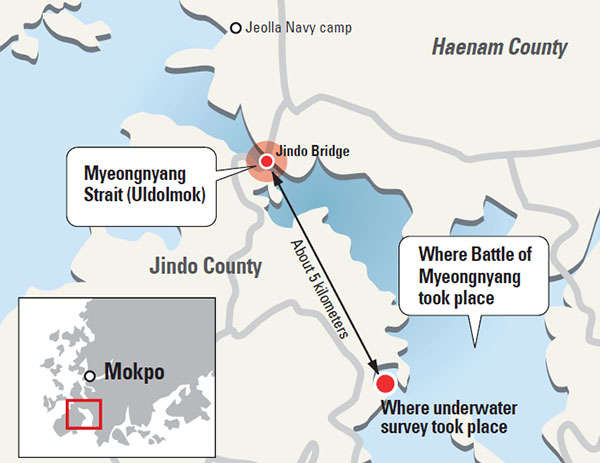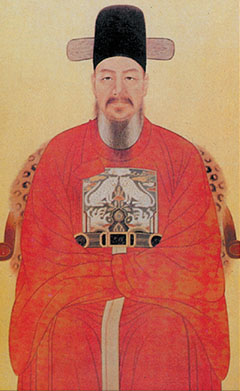Items from the sea recall an epic battle

From left, a girin-shaped cap for incense burners, a duck-shaped cap and three guns presumed to have been used in the Battle of Myeongnyang in 1597. Provided by the institute
It was David facing Goliath.
Near the end of the period of attempted Japanese invasions known as the Imjin War (1592-98), Korea was attacked again in 1597.
Six years of fighting had left the country devastated and its once-powerful navy taking on water. The Japanese seemed poised to seize the advantage on the high seas at last.

But all that changed on Sept. 16, 1597, in the legendary Battle of Myeongnyang Strait. On that day, according to Korean documents, Admiral Yi Sun-shin’s (1545-98) fleet of 13 ships defeated a force of 133 Japanese vessels.
Now, Korean archaeologists have found three guns thought to have been used by the Koreans at the famous battle. The National Research Institute of Maritime Cultural Heritage announced on Nov. 28 it had discovered the guns, stone bullets and pale green-blue celadon works from the Goryeo Dynasty (916-1932) off Jin Island, about 5 kilometers (3.1 miles) south of Myeongnyang Strait.
Though they have been in the sea for hundreds of years, the engraving on the guns looks as if it could have been done last week and the celadon pieces have retained their glow.
It’s the first time Battle of Myeongnyang Strait items have been found, and all the more special because 2012 is the year of the dragon and the 420th anniversary of the Imjin War. There has been a spike in interest in the war, as evidenced by an ongoing exhibit at the War Memorial of Korea in Yongsan, central Seoul, which brought together 69 Imjin War-related documents, paintings, weaponry and other items, some of them state treasures.

Admiral Yi Sun-shin [JoongAng Ilbo]
“These are Sososeungja Chongtong made in April of 1588 for the Jeolla Left Navy. The weight is three geun and nine nyang [about 2 kilograms], and the artisan’s name is Yun Deok-yeong.”
The passage is from engravings in Chinese characters on the three guns, which measure 58 centimeters (23 inches) long and 3 centimeters in diameter.
The Jeolla Navy camp had two headquarters: Jeolla Left Navy and Jeolla Right Navy. And chongtong in Korean refers to rifles.
Officials at the Research Institute of Maritime Cultural Heritage note how the term “Sososeungja-types” does not appear in any known documents nor has any of them found in reality.
Officials say, “sososeungja-types” are similar to, or slightly altered version of, the “soseungja-types,” firearms made for private use in the mid-Joseon Dynasty, but the former have a smaller diameter and thus a longer range. “Soseungja-types” are believed to have had a range of about 120 meters (131 yards).
Also found during the survey were stone bullets, 8.6 centimeters in diameter and weighing 715 grams (1.6 pounds), presumed to have been used by the Korean navy during the Imjin War. Officials say the findings are in line with Admiral Yi’s strategy of firing from long range then crashing in close range.
“It is almost certain sure that the guns are related to Admiral Yi Sun-shin and his great victory in the Myeongryang Strait, judging from the fact that they were produced just before the Imjin War by the Jeolla Left Navy and discovered near the historical site of the victory,” said Seong Nak-jun, head of the research institute. “The discovery will serve as an important chance to study the Imjin War and Korea’s history of developing weapons.”
Yi, famed for designing the turtle ship, or geobukseon, is considered a national hero and his statue has stood in Sejongno, the main road in downtown Seoul, since the late 1960s. People of the Jeolla region re-enact the Myeongnyang Strait battle each year.
Treasure ship?
“Look at these details - the twisted tail, the teeth, the tongue. This is amazing.”
Kim Young-won, the director general of the National Research Institute of Cultural Heritage and a celadon expert, couldn’t hide her awe as she examined the cap of an incense burner that features a legendary animal called the girin, which has the body of a dear, tail of a cow, hoof of a horse and a horn like a unicorn.
Only four such pieces are known to exist. One at Kansong Art Museum built in 1938 by legendary collector Jeon Hyeong-pil. It was thought to be a cherished item of Jeon’s and is National Treasure No. 65. The other three are at the National Museum of Korea, AmorePacific Museum of Art and the Museum of Oriental Ceramics in Osaka.
Kim said the celadon pieces found were made from the 12th century to the 14th century, and probably belonged to either the royal family or noblemen.
Officials at the research institute believe they were being transferred from Gangjin, where the Goryeo artisans made celadon pieces for royal palaces, to Kaesong, Goryeo’s capital.
Other important celadon pieces found from the underwater survey are a duck-shaped incense burner cap and a brush-holder decorated with a lotus bud. Kim noted how even the bottom of the cap has flower-shaped decorations, saying the attention to detail is astonishing.
So why were Joseon weapons and Goryeo ceramics found at the same spot?
One has to understand the excavation site, officials say. It’s close to the Myeongnyang Strait, called Uldolmok among Koreans. Uldol roughly translates as “crying stone.”
The currents there are notoriously strong and fast, and experts say it is undoubtedly one of Korea’s most dangerous sea routes. That is why Admiral Yi chose the area for the epic battle.
It was also the route that boats rounding the peninsula would sail to shorten their trip. But it was risky, and many ships sank. That is why what’s underneath the waters could well be a “Gyeongju in the sea,” a reference to the historic treasure-laden city.
Unexpected help
The underwater survey was initiated after a ring of cultural-property thieves was caught in November 2011 illegally excavating Goryeo celadon from the area.
The National Research Institute of Maritime Cultural Heritage began a preliminary survey in September. Officials say the delay was due to the thieves giving false information about the exact location.
The early survey turned up nine stones used to weigh down anchors plus 32 celadon pieces. So the research institute did a full survey of the area from Oct. 4 to Nov. 25. And officials at the institute say the area covered so far is less than 0.8 percent of the total area they eventually plan to survey. So far, 124 items have been found.
The Cultural Heritage Administration said it will designate the waters where the underwater survey will take place, about 90,000 square meters (970,000 square feet), as an important cultural heritage and begin a second survey in May.
“Eventually, we hope to find a boat,” said Lim Kyoung-hee, a curator at the research institute’s underwater excavation and conservation division. She added that Korea has unearthed only 11 ancient boats, nine of which belonged to Korea’s Goryeo era with two belonging to China.
Officials say there is the possibility of finding a Japanese vessel, as records say 31 were sunk by Admiral Yi’s fleet in the Battle of Myeongnyang Strait.
But the process will be painstaking, as it has been so far. “It’s total darkness down there,” said Moon Hwan-sik, manager at the institute’s underwater excavation and conservation division, adding that when tidal currents are at their weakest, the visibility range is 10 meters to 30 meters and when they are strong, the visibility range is zero.
In recent years, Korea has invested heavily in underwater archaeology and it claims to be the best in Asia. The National Research Institute of Maritime Cultural Heritage has conducted a survey on an 800-year-old shipwreck near Taean’s Mado Island, South Chungcheong, after getting a tip from haenyeo, female divers. Numerous items such as wooden invoices, ceramics, and golden and wooden artifacts have been found.
Also, Korea plans to introduce a brand new ship dedicated to underwater archaeology next May.
By Kim Hyung-eun [hkim@joongang.co.kr]










with the Korea JoongAng Daily
To write comments, please log in to one of the accounts.
Standards Board Policy (0/250자)